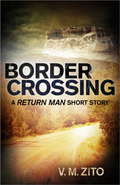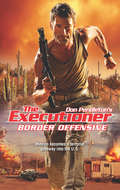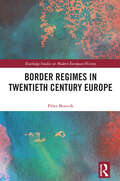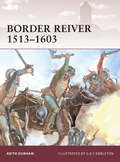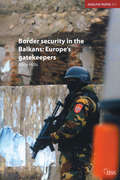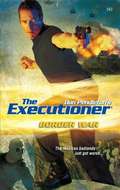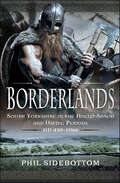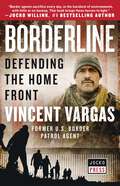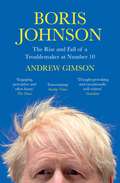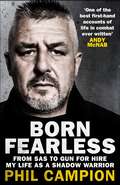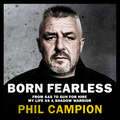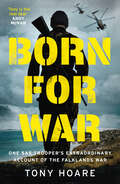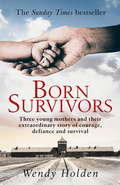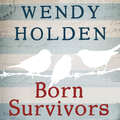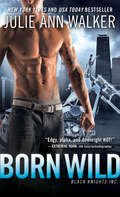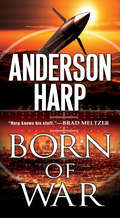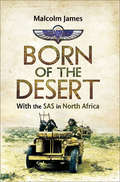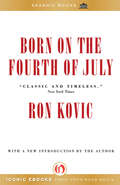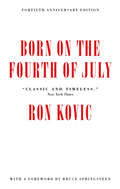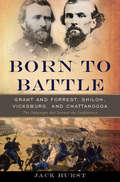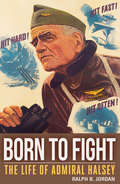- Table View
- List View
Border Crossing: A Return Man Short Story
by V. M. ZitoA thrilling, post-apocalyptic short story from the world of V. M. Zito's THE RETURN MAN: 'Bloody excellent' Financial Times.Corporal Noah Brodeur's job is a lonely one. In the aftermath of the outbreak, from his remote Canadian border station, Brodeur must guard the Slinky: a formidable wall protecting his countrymen from the Evacuated States and the ravenous creatures that roam there.All is quiet until the day a stranger emerges from the safe side of the forest. He says he is on a classified mission for the CIA. He says his name is Special Agent Kenneth Wu. He demands that Brodeur break rank and allow him across the border into danger.But when everything is at stake, can appearances be trusted? And on the edge of civilisation, who is more dangerous, the living . . . or the dead?Praise for THE RETURN MAN:'Zito expertly piles on thrills, cliffhangers and numerous twists, investing renewed life into the shambling, cliché-ridden corpse of the zombie subgenre.' Guardian'An overload of thrills, spills and adventure.' Sun'Hands down one of the best zombie novels I've read in a long, long time. From first page to last, THE RETURN MAN is an astonishing read. With characters you genuinely give a damn about and a story that'll keep you turning page after page, this is an outstanding debut.' David Moody, author of Autumn'In a word: relentless.' Sunday Telegraph'Contagion meets Mad Max.' The Times
Border Crossing: A Return Man Short Story
by V. M. ZitoA thrilling, post-apocalyptic short story from the world of V. M. Zito's THE RETURN MAN: 'Bloody excellent' Financial Times.Corporal Noah Brodeur's job is a lonely one. In the aftermath of the outbreak, from his remote Canadian border station, Brodeur must guard the Slinky: a formidable wall protecting his countrymen from the Evacuated States and the ravenous creatures that roam there.All is quiet until the day a stranger emerges from the safe side of the forest. He says he is on a classified mission for the CIA. He says his name is Special Agent Kenneth Wu. He demands that Brodeur break rank and allow him across the border into danger.But when everything is at stake, can appearances be trusted? And on the edge of civilisation, who is more dangerous, the living . . . or the dead?Praise for THE RETURN MAN:'Zito expertly piles on thrills, cliffhangers and numerous twists, investing renewed life into the shambling, cliché-ridden corpse of the zombie subgenre.' Guardian'An overload of thrills, spills and adventure.' Sun'Hands down one of the best zombie novels I've read in a long, long time. From first page to last, THE RETURN MAN is an astonishing read. With characters you genuinely give a damn about and a story that'll keep you turning page after page, this is an outstanding debut.' David Moody, author of Autumn'In a word: relentless.' Sunday Telegraph'Contagion meets Mad Max.' The Times
Border Guard: The Story of the U.S. Customs Service
by Don WhiteheadBorder Guard, first published in 1963 by Pulitzer-winning journalist Don Whitehead, is a look at the efforts of the U.S. Customs Service (now U.S. Customs and Border Protection) to secure America’s borders and ports of entry from illegal items and to collect duties. (As noted by the author, before the implementation of the federal income tax, customs duties were the only source of revenue for the government.) Chapters deal with the major issues facing the Service, including illegal drugs, diamond smuggling, stolen works of art, organized crime networks, and pornography; numerous case histories are provided to illustrate the work of the Service. A chapter is also devoted to the origins of the customs service from the earliest days of the United States.
Border Offensive
by Don PendletonBlood Toll American smugglers intent on running terrorists across the Mexican border don't realize that the extra man they've picked up en route is working undercover to stop them. Or that the man is Mack Bolan and he's dedicated to preventing their treacherous human cargo from ever reaching the U.S.Partnered with a border patrol agent, Bolan needs to come up with a Plan B fast when their covers are blown...or risk the country coming under a devastating terror attack. The Executioner is setting up his own form of border patrol and no one is crossing without his permission.
Border Regimes in Twentieth Century Europe (Routledge Studies in Modern European History)
by Péter BencsikThis book offers a comprehensive and comparative analysis of the history of passports, border surveillance, border crossing, and other elements of European border regimes in the twentieth century. Border regime is interpreted widely, including inbound and outbound travels, permanent and temporary movements, distance and local border traffic, borderland fortifications, penalties for borderland offences, and also restrictions of free movement even inside a given country. Based on archival sources from Hungary and the Czech Republic, extensive literature and more than two decades of research, the author distinguishes between two basic border regimes, the restrictive eastern and the permissive western systems, and a transitional zone between them. The historical development of these regimes is discussed in the framework of waves of globalisation and territorialisation. Border Regimes in Twentieth Century Europe offers the first ever systematic comparison of European border regimes for students, scholars, and any readers who are interested in travel history, border studies, globalisation, area studies and twentieth century Europe, including everyday history. By presenting their different historical experiences, the book contributes to a better understanding between old and new member states of the European Union, as well as between member and non-member states.
Border Reiver 1513-1603
by Keith DurhamStretching from the North Sea to the Solway Firth, the Border region has a sharply diverse landscape and was a battleground for over 300 years as the English and Scottish monarchs encouraged their subjects to conduct raids across their respective borders. This Warrior title will detail how this narrow strip of land influenced the Borderer's way of life in times of war. Covering every aspect of militant life, from the choice of weapons and armor to the building of fortified houses, this book gives the readers a chance to understand what it must have been like to live life in a late-medieval war zone.
Border Security in the Balkans: Europe Gatekeepers (Adelphi series)
by Alice HillsBorders dominate the security agenda in South-east Europe. Political and ethnic discontents focus on disputed borders, while traffickers in migrants and drugs ignore them.The EU argues that the Balkan countries should develop models of border management using its policing standards, but the region is rife with corruption and its border guards are both under-resourced and ineffective. This Paper asks how and why border management in South-east Europe is developing as it is, and what this might mean for the future of Europe. Drawing on recent experience in Bosnia, Herzegovina, Slovenia, Macedonia and Albania, it looks at the ways in which the regions' borders are managed, and gauges the development of a consensual European approach to border security. It shows how governments and guards understand the predicament of regional insecurity, and how they respond with strategies that accommodate, evade or subvert unavoidable political pressures.
Border War (Executioner #343)
by Don PendletonMEXICAN STANDOFF Mack Bolan makes a hard probe into the ritualized execution of four U.S. border patrol agents and a U.S. Marshal. His target is a cartel across the border with a hand in just about every illegal activity-drugs, guns, whatever produces lots of easy dinero. Convinced that there are treasonous Americans in the mix, Bolan becomes a one-man blitzkrieg across the Rio Grande, kicking butt and taking names. He goes undercover as one of the best of the worst, infiltrating the mercenaries who've sold themselves and their country for a taste of power and money. The Executioner is hungry, too, but for a different kind of meal: cold, hard
Borderlands: South Yorkshire in the Anglo-Saxon and Viking Periods. AD 450–1066
by Phil SidebottomAn accessible overview that will interest anyone who wants to know more about South Yorkshire during the Viking era. The period AD 450-1066 was a tumultuous time for the British Isles, and this was in particularly true of what became South Yorkshire. Existing on the borderland between the great Anglo-Saxon kingdoms of Mercia and Northumbria, South Yorkshire remained contentious in the struggles between the rival polities, with land ceded and taken, over the best part of four centuries. Evidence suggests that most of southern Yorkshire remained largely occupied by native British inhabitants, rather than Saxon or Viking incomers, at least until the later-Saxon period and after the Viking take-over which began in the 9th century. With a focus on the previously academically-neglected archaeology of the region, this book features new evidence to paint a full picture of South Yorkshire in the Anglo-Saxon and Viking Periods. Included are pre-Conquest charters and the enigmatic Tribal Hidage tribute list, as well as an analysis of place-names and looks at the archaeological record of dark-age earthworks, burials, fortified places and finds. The author uses his expert knowledge of Anglo-Saxon carved stone monuments to supplement the historical and archaeological evidence to identify centers of settlement and control in the area and which also offers a tantalizing insight into local ethnicity. The research is brought to life with maps, figures, and photographic evidence throughout the book. In pulling together our current knowledge of South Yorkshire during this pivotal era, the book acts as a reminder of how the wealth of local character is easily destroyed unless we become more aware of its fragility and celebrate its diversity. Written in accessible language, this book will be of interest to both academics and anyone who wants to know more about South Yorkshire in the post-Roman and Early Medieval periods.
Borderless Wars
by Antonia ChayesIn 2011, Nasser Al-Awlaki, a terrorist on the US 'kill list' in Yemen, was targeted by the CIA. A week later, a military strike killed his son. The following year, the US Ambassador to Pakistan resigned, undermined by CIA-conducted drone strikes of which he had no knowledge or control. The demands of the new, borderless 'gray area' conflict have cast civilians and military into unaccustomed roles with inadequate legal underpinning. As the Department of Homeland Security defends against cyber threats and civilian contractors work in paramilitary roles abroad, the legal boundaries of war demand to be outlined. In this book, former Under Secretary of the Air Force Antonia Chayes examines these new 'gray areas' in counterinsurgency, counter-terrorism and cyber warfare. Her innovative solutions for role definition and transparency will establish new guidelines in a rapidly evolving military-legal environment.
Borderline: Defending the Home Front
by Vincent VargasAn inside look at the U.S.-Mexico border through the eyes of former U.S. Border Patrol agent, Vincent Vargas, who served in Iraq and Afghanistan with the U.S. Army’s 75th Ranger Regiment.Featuring a Foreword by #1 New York Times bestselling author Jocko Willink.The U.S.-Mexico border stretches nearly two thousand miles and is protected by a thin line of overworked and underfunded U.S. Border Patrol Agents who risk their lives every day. They are stigmatized in the media and fought over in the halls of Washington D.C., and Borderline shares their story: the truth of what is really happening on the U.S.-Mexico border.The story begins on the battlefields of the Middle East and culminates on the southwest border of the United States, where Vargas was tasked with protecting his country, his fellow agents, and the immigrants caught in the middle. He learned firsthand about the unforgiving brutality of the cartels, human traffickers, and the desert. After bearing witness to the carnage, Vargas made the decision to join the Border Patrol’s elite search-and-rescue unit called BORSTAR.With almost unfettered access, Vargas provides an in-depth, never-before-seen look into the U.S. Border Patrol, from the agency’s origins to its present-day missions.
Boris Johnson: The Rise and Fall of a Troublemaker at Number 10
by Andrew GimsonAndrew Gimson, whose previous book Boris is the essential read on Johnson's earlier career, returns with a penetrating and entertaining new account of Boris Johnson's turbulent time as prime minister, from the highs of a landslide election victory to the lows of his car-crash resignation. In Boris Johnson: The Rise and Fall of a Troublemaker at Number 10, Gimson sets out to discover how a man dismissed as a liar, charlatan and tasteless joke was able, despite being written off more frequently than any other British politician of the twenty-first century, to become prime minister. During his ascent, Johnson benefited from being regarded as a clown, for this meant his opponents failed to take him seriously, while his supporters delighted in his ability to shock and enrage the Establishment. He even changed the language of politics; a new word, &‘cakeism&’, entered the English lexicon to describe his implausible but seductive claim during the Brexit negotiations that it was possible to have one&’s cake and eat it. In a series of brilliant vignettes, Gimson sheds light on the parts played by sex, greed, boredom and low seriousness in Johnson&’s rise and fall, describes how Partygate fatally imperilled his prime ministership, and places him in a line of Tory adventurers stretching back to Benjamin Disraeli: disreputable figures who often blew themselves up, but who also could display an astonishing ability to connect with the British public.What kind of a person is Johnson? What kind of a country would dream of making him its prime minister? And why did he fall? Nobody has got closer than Gimson to finding out the answers.
Born Fearless: From Kids' Home to SAS to Pirate Hunter - My Life as a Shadow Warrior
by Phil Campion'Hard eyes stare out of massive beards, their faces marked by the scars of battle. With these guys their webbing looks like it belongs to them, rather than it's been hung on a pair of reluctant shoulders. There's not a word been said to us, but the ante has clearly been upped. There's a dark and sinister feeling in the air. It doesn't take a genius to figure it's about to kick off.' Former SAS soldier Big Phil Campion tells it like is in this brutally honest account of his insanely dangerous life as a private military operator. From playing chicken with a suicide bomber in backstreet Kabul, to taking on pirates with his bare hands, this is true-life action-packed drama at its best.
Born Fearless: From Kids' Home to SAS to Pirate Hunter - My Life as a Shadow Warrior
by Phil CampionThe explosive true story of a gun for hire.'Hard eyes stare out of massive beards, their faces marked by the scars of battle. With these guys their webbing looks like it belongs to them, rather than it's been hung on a pair of reluctant shoulders. There's not a word been said to us, but the ante has clearly been upped. There's a dark and sinister feeling in the air. It doesn't take a genius to figure it's about to kick off.' Former SAS soldier Big Phil Campion tells it like is in this brutally honest account of his insanely dangerous life as a private military operator. From playing chicken with a suicide bomber in backstreet Kabul, to taking on pirates with his bare hands, this is true-life action-packed drama at its best.(P) 2019 Quercus Editions Limited
Born For War: One SAS Trooper's Extraordinary Account of the Falklands War
by Tony Hoare'Tony is the real deal.' Andy McNabThe full, explosive, boots-on-the-ground story of the Falklands War, from a soldier at the heart of the action, published for the 40th anniversary of the conflict. Tony Hoare always knew he wanted to be in the SAS.Both his grandfather and father had been soldiers, and so Tony signed up for the Cadets at 13, then the Infantry at 17 and enlisted into the Royal Green Jackets before passing arduous SAS selection in 1978.Less than four years later, Tony and his team were sent to a collection of islands just off the coast of Argentina called the Falklands, where tensions were rising and war was on the horizon.No amount of training could prepare Tony for what happened over the course of the next twelve weeks, as the Falkland Islands became a battleground between British and Argentinian forces. As helicopters crashed and ships sank, Tony, at the centre of the action, battled across treacherous terrain and against a fearsome enemy, doing whatever it took to retake the islands.From one of the only soldiers who was on the frontline throughout the entire conflict, this is a thrilling account of what really happened in the Falklands, an explosive story of land, sea and air battles from a trooper who saw it all.
Born For War: One SAS Trooper's Extraordinary Account of the Falklands War
by Tony Hoare'Tony is the real deal.' Andy McNabThe full, explosive, boots-on-the-ground story of the Falklands War, from a soldier at the heart of the action, published for the 40th anniversary of the conflict. Tony Hoare always knew he wanted to be in the SAS.Both his grandfather and father had been soldiers, and so Tony signed up for the Cadets at 13, then the Infantry at 17 and enlisted into the Royal Green Jackets before passing arduous SAS selection in 1978.Less than four years later, Tony and his team were sent to a collection of islands just off the coast of Argentina called the Falklands, where tensions were rising and war was on the horizon.No amount of training could prepare Tony for what happened over the course of the next twelve weeks, as the Falkland Islands became a battleground between British and Argentinian forces. As helicopters crashed and ships sank, Tony, at the centre of the action, battled across treacherous terrain and against a fearsome enemy, doing whatever it took to retake the islands.From one of the only soldiers who was on the frontline throughout the entire conflict, this is a thrilling account of what really happened in the Falklands, an explosive story of land, sea and air battles from a trooper who saw it all.
Born Survivors: The incredible true story of three pregnant mothers and their courage and determination to survive in the concentration camps
by Wendy HoldenThe Sunday Times bestseller now updated with a new forewordAmong millions of Holocaust victims sent to Auschwitz II-Birkenau in 1944, Priska, Rachel, and Anka each passed through its infamous gates with a secret. Strangers to each other, they were newly pregnant, and facing an uncertain fate without their husbands. Alone, scared, and with so many loved ones already lost to the Nazis, these young women were privately determined to hold on to all they had left: their lives, and those of their unborn babies.That the gas chambers ran out of Zyklon-B just after the babies were born, before they and their mothers could be exterminated, is just one of several miracles that allowed them all to survive and rebuild their lives after World War II. Born Survivors follows the mothers' incredible journey - first to Auschwitz, where they each came under the murderous scrutiny of Dr. Josef Mengele; then to a German slave labour camp where, half-starved and almost worked to death, they struggled to conceal their condition; and finally, as the Allies closed in, their hellish 17-day train journey with thousands of other prisoners to the Mauthausen death camp in Austria. Hundreds died along the way but the courage and kindness of strangers, including guards and civilians, helped save these women and their children.Sixty-five years later, the three 'miracle babies' met for the first time at Mauthausen for the anniversary of the liberation that ultimately saved them. United by their remarkable experiences of survival against all odds, they now consider each other "siblings of the heart." In Born Survivors, Wendy Holden brings all three stories together for the first time to mark their seventieth birthdays and the seventieth anniversary of the ending of the war.A heart-stopping account of how three mothers and their newborns fought to survive the Holocaust, Born Survivors is also a life-affirming celebration of our capacity to care and to love amid inconceivable cruelty.
Born Survivors: The incredible true story of three pregnant mothers and their courage and determination to survive in the concentration camps
by Wendy HoldenThis recording includes an exclusive interview with Eva Clarke who was born in the Mauthausen death campAmong millions of Holocaust victims sent to Auschwitz II-Birkenau in 1944, Priska, Rachel, and Anka each passed through its infamous gates with a secret. Strangers to each other, they were newly pregnant, and facing an uncertain fate without their husbands. Alone, scared, and with so many loved ones already lost to the Nazis, these young women were privately determined to hold on to all they had left: their lives, and those of their unborn babies.That the gas chambers ran out of Zyklon-B just after the babies were born, before they and their mothers could be exterminated, is just one of several miracles that allowed them all to survive and rebuild their lives after World War II. Born Survivors follows the mothers' incredible journey - first to Auschwitz, where they each came under the murderous scrutiny of Dr. Josef Mengele; then to a German slave labour camp where, half-starved and almost worked to death, they struggled to conceal their condition; and finally, as the Allies closed in, their hellish 17-day train journey with thousands of other prisoners to the Mauthausen death camp in Austria. Hundreds died along the way but the courage and kindness of strangers, including guards and civilians, helped save these women and their children.Sixty-five years later, the three 'miracle babies' met for the first time at Mauthausen for the anniversary of the liberation that ultimately saved them. United by their remarkable experiences of survival against all odds, they now consider each other "siblings of the heart." In Born Survivors, Wendy Holden brings all three stories together for the first time to mark their seventieth birthdays and the seventieth anniversary of the ending of the war.A heart-stopping account of how three mothers and their newborns fought to survive the Holocaust, Born Survivors is also a life-affirming celebration of our capacity to care and to love amid inconceivable cruelty.
Born Wild (Black Knights Inc. #5)
by Julie Ann WalkerA New York Times and USA Today Bestseller!"Drama, danger and sexual tension... Romantic suspense at its best."—Night Owl Reviews, 5/5 Stars, Reviewer Top PickThe rules she lives by are meant to keep her and her heart safe. But when her life is on the line, can does she dare risk her heart?"Wild" Bill Reichert knows a thing or two about explosives. The ex-Navy SEAL can practically rig a bomb blindfolded. But there's no way to diffuse the inevitable fireworks the day Eve Edens walks back into his life, asking for help…Eve doesn't know what to do when the Chicago police won't believe someone is out to hurt her. The only place to turn is Black Knights Inc—after all, no one is better at protection than the covert special-ops team. Yet there's also no one better at getting her all turned on than Billy Reichert. She has a feeling this is one blast from the past that could backfire big time…Black Knights Inc. SeriesHell on Wheels (Book 1)In Rides Trouble (Book 2)Rev It Up (Book 3)Thrill Ride (Book 4)Born Wild (Book 5)Hell for Leather (Book 6)Full Throttle (Book 7)Too Hard to Handle (Book 8)Wild Ride (Book 9)Fuel for Fire (Book 10)Hot Pursuit (Book 11)
Born of War (A Will Parker Thriller #3)
by Anderson HarpAn act of terror hits American soil and high-tech mayhem rocks the globe in this explosive thriller by an acclaimed author and military veteran. The first target is a church in Mobile, Alabama. The bomb is a savage act of domestic terror that will earn the respect of jihadists across the world. Especially the deranged leader of Al Shabab. The bombing has also drawn the attention of the FBI, CIA, NSA—and special operative William Parker. Recovering from a tragic loss, Parker is not ready to return to active duty. But when he learns that the terrorists possess anti-ship missiles—he must destroy the enemy . . . or deal with the terrifying consequences. Time is running out. Missiles are ready to launch. And the free world is just one madman away from total destruction.Praise for Anderson Harp&’s Retribution &“Harp knows his stuff.&” —Brad Meltzer &“Tense and authentic--reading this book is like living a real-life mission.&” —Lee Child &“An outstanding thriller . . . Harp writes with complete authenticity.&” —Douglas Preston &“Reminds me of Tom Clancy at his finest.&” —James Rollins
Born of the Desert: With the SAS in North Africa
by Malcolm JamesBorn of the Desert is a classic account of the early years of the SAS. The Special Air Service was formed in 1941 and quickly earned a reputation for stealth, daring and audacity in the Western Desert Campaign. This elite force utilised the endless expanse of the desert to carry out surprise attacks and hit and run raids behind the Afrika Korps' lines, sowing confusion, fear and consternation. Malcolm James served as Medical Officer with the SAS throughout 1942 and 1943, and Born of the Desert is his atmospheric account of his life in the North African desert, the bitter fighting against Italian and German targets and the forging of a remarkable elite unit. James captures the excitement of this dramatic mode of warfare and brings to life the deadly beauty of the desert, the harsh environment and the strong bonds of comradeship and interdependence which resulted. Born of the Desert was written soon after the events depicted and has an immediacy which places it above other Second World War memoirs. The original text has now been augmented by supplementary notes by David List, and appendices on SAS casualties and awards by David Buxton.
Born on the Fourth of July
by Ron KovicKovic's powerful and moving New York Times bestselling book, now with a new introduction that sets this classic antiwar story in a contemporary context This New York Times bestseller (more than one million copies sold) details the author's life story (portrayed by Tom Cruise in the Oliver Stone film version)--from a patriotic soldier in Vietnam, to his severe battlefield injury, to his role as the country's most outspoken anti-Vietnam War advocate, spreading his message from his wheelchair.
Born on the Fourth of July: 40th Anniversary Edition
by Ron KovicThis edition marks the 40th anniversary of the original publication of Kovic's American antiwar classic. “Classic and timeless!” —New York Times “As relevant as ever, this book is an education. Ron is a true American, and his great heart and hard-won wisdom shine through these pages.” —Oliver Stone, filmmaker This New York Times best seller (more than one million copies sold), presented here in a special fortieth-anniversary edition with a brand-new foreword by Bruce Springsteen, details the author’s life story (portrayed by Tom Cruise in the Oliver Stone film)—from a patriotic soldier in Vietnam, to his severe battlefield injury, to his role as the country’s most outspoken anti–Vietnam War advocate, spreading his message from his wheelchair.
Born to Battle: Grant and Forrest--Shiloh, Vicksburg, and Chattanooga
by Jack HurstBorn to Battleexamines the Civil War’s complex and decisive western theater through the exploits of its greatest figures, Ulysses S. Grant and Nathan Bedford Forrest. These two opposing giants squared off in some of the most epic campaigns of the war, starting at Shiloh and continuing through Perryville, Vicksburg, Chickamauga, and Chattanooga-battles in which the Union would slowly but surely divide the western Confederacy, setting the stage for the final showdowns of the bloody, protracted conflict. Grant is widely regarded as the man most responsible for winning the war for the Union, Forrest as the Confederacy’s most fearsome defender in the West. Both men had risen through their respective hierarchies thanks to their cunning and military brilliance, and despite their checkered pasts. Grant and Forrest were both "lower”-born officers who struggled to overcome particular, dubious reputations (Forrest’s as a semi-literate rustic and Grant’s as a doltish drunkard). In time, however each became renowned for his intelligence, resourcefulness, and grit. Indeed, as Hurst shows, their familiarity with hardship gave both men a back-against-the-wall mindset that would ultimately determine their success-both on the battlefield, and off it. Beginning with the Union victory at Tennessee’s Fort Donelson in February 1862 (when Grant handed the Union the largest force ever captured on American soil, refurbishing his reputation and earning himself the nickname "Unconditional Surrender Grant”), Hurst follows both men through the campaigns of the next twenty months, showing how this critical period-and these two unequaled leaders-would change the course of the war. Again and again, Grant’s hardscrabble tactics saved Federal forces from the disastrous decisions of his fellow commanders, who seemed unable to think outside of the West Point playbook. Just as often, Forrest’s hot temper and wily, frontier know-how would surprise his Federal adversaries and allow him to claim astonishing victories on behalf of the Confederacy. But as Grant pressed south and east over the course of these twenty months, routing Confederate forces at such critical strongholds as Corinth, Vicksburg ("Gibraltar of the Mississippi”), and Chattanooga, the systemic differences between the North and South began to tell. The more inclusive, meritocratic Union allowed Grant to enter into the military’s halls of decision, whereas the proudly aristocratic Confederate high command barred Forrest from contributing his input. As Hurst vividly demonstrates, that disparity affected, and possibly dictated, the war’s outcome. Thoroughly disgusted with his disdainful superiors and their failure to save his home state of Tennessee from the clutches of the Union, Forrest eventually requested a transfer to a backwater theater of the war. Grant, by contrast, won command of the entire Union army following his troops’ stunning performance at Chattanooga, and would go on to lead the North to victory over the forces of another exceptional Southern general: Robert E. Lee. An utterly American tale about class, merit, and their role in one of the most formative wars in the nation’s history,Born to Battleoffers an impassioned account of two visionary Civil War leaders and the clashing cultures they fought-in some cases, quite ironically-to protect. Hurst shows how Grant and Forrest brought to the battlefield the fabled virtues of the American working-class: hard work, ingenuity, and intense determination. Each man’s background contributed to his triumphs on the battlefield, but the open-mindedness of his fellow commanders proved just as important. When the North embraced Grant, it won a stalwart defender. When the South rejected Forrest, by contrast, it sealed its fate.
Born to Fight: The Life of Admiral Halsey
by Ralph B. JordanBorn to Fight, first published in 1946, is an easy-to-read account of the life of Admiral William 'Bill' or 'Bull' Halsey, from his childhood through the surrender of the Japanese aboard his flagship, the USS Missouri, on September 2, 1945 (Halsey passed away in 1959). Much of the book follows his career and decision-making in the Pacific. His aggressiveness, in part, stemmed from his intense dislike of the Japanese. A strong leader, willing to break the rules when needed, and much respected by those under his command, Born to Fight is an insightful look at one of the war's more important – and certainly one of its most colorful – characters. When asked about his role in the war, Halsey stated “There are no great men, just great challenges which ordinary men, out of necessity, are forced by circumstances to meet.” Included are 15 pages of photographs.
